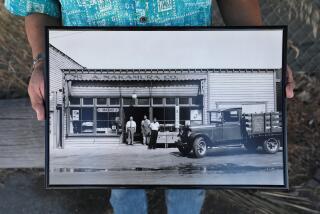Weathered Work of Folk Art May Face Demolition : Simi Valley: Whimsical collection of structures may be leveled unless shored up. Some want Bottle Village saved; others say it’s an eyesore.
- Share via
Each day, Janice Wilson breezes down a bustling Simi Valley street, past rows of cookie-cutter houses, to a ramshackle one-acre fantasy land.
There, beneath a dozen drooping eucalyptus trees, Wilson tends to a collection of miniature trees dripping with toothbrushes, buildings made of bottles, and gardens sprouting doll heads and bedsprings.
For three years, Wilson, a custodian at a Simi Valley elementary school, has shouldered the awesome task of caring for Bottle Village, a whimsical collection of 13 child-sized buildings and sculptures made almost entirely of junk.
To Wilson, the village is an inspiring creation worth preserving. But to many of the village’s neighbors, it’s an eyesore they’d rather see destroyed.
The one-acre village was created by resident Tressa Prisbrey three decades ago and has been internationally recognized as a valuable work of folk art. It has been closed to the public for 11 years because of unsafe conditions.
Locked behind an iron gate at 4595 Cochran St., roofs leak, walls crumble, and the toothbrush trees and doll heads whither and rot at the whim of sun, wind and rain.
There have long been plans to restore the deteriorating structures, but a lack of community interest has left the landmark to limp along under the care of a few die-hard supporters who call themselves the Preserve Bottle Village Committee.
Now, in order to comply with an ordinance passed several years ago, the committee must supply the city with a plan by June to make the village earthquake-proof, or face its possible demolition.
“There is so much that needs to be done,” Wilson said. “What we really need is someone who is familiar with how the city works, who can help us work through the red tape and organize people who are interested in helping.”
City officials say the chances of the village being torn down are slim--supporters can always ask for an extension--but Wilson says the committee can’t afford to hire an engineer to conduct the study. She said that unless the committee can rouse community support, the village will continue to languish.
Hoping to boost local interest in the village, Wilson has launched two projects: an educational video about the village and a grant-funded reprinting of a booklet by Prisbrey, known as “Grandma” Prisbrey, offering a lively introduction to the village.
“A collection of bottles, all shapes and sizes, started to find their way to my front yard,” Prisbrey wrote. “Putting them together in a heap invited me to do something with them . . . thus began Bottle Village.”
Wilson said she plans to distribute the booklet and video to schools throughout the city, with the hope that they will be incorporated into lessons on local history.
“Children in particular really love Bottle Village,” said Wilson, who said Prisbrey’s work inspired her to use junk in her own art. “They like the colors and all the neat things Grandma collected.”
Prisbrey began building the village around her trailer home in 1955, continuing to work on it for almost two decades.
The project began as a simple plan to build a storage space for the 2,000 pencils she had collected from store giveaways and political campaigns.
In search of bricks, she visited a dump and discovered a wealth of the Milk of Magnesia and beer bottles that were to become the building blocks for the entire village.
When the Pencil House was completed, Prisbrey continued to visit the dump. Each day, she filled her Studebaker truck with old tires, headlights and television tubes, which wound up as parts of rooms and sculptures with quirky names like the Rumpus Room, Cleopatra’s Bedroom, the Leaning Tower of Bottle Village and the Round House.
The bottles gave each room a stained-glass, church-like glow as the light worked its way through thousands of cobalt-blue and amber bottles. The ceilings were covered with swaths of colored fabric, the walls with old posters and photographs painted over and decorated with shells, pennies and pine cones. She decorated the floors and walkways with tile, stone and glass mosaics one art critic dubbed “brickolage.”
Word about Bottle Village spread through the art community, and Prisbrey began receiving visitors from around the world. Several sculptures from the village toured with museum shows. The village was designated a historic landmark by the state and Ventura County, and was awarded a plaque of recognition by the Folk Art Society of America.
Fans of the village hoped that the accolades would stir up local interest, but by Prisbrey’s death in 1988 at the age of 92, support had not materialized.
A local church group has volunteered to mount the plaque commemorating the village’s state historic landmark status in the next few weeks--more than 10 years after the honor was bestowed.
Most residents are either not interested in Bottle Village or consider it kitschy and unattractive, Wilson said.
“I think if people really took the time to come and look at it and think about it, they would see beyond the messiness and see the beauty here,” Wilson said.
But civic leaders said they doubt that Bottle Village will ever gain the support it needs to be fully restored.
“I think what this lady did over her lifetime is worth preserving,” Councilman Bill Davis said. “The problem is dollars and cents, and getting enough interest and activity to see it happen.”
Councilwoman Judy Mikels said she, too, would like to see the village restored, but does not think that there is enough support to make it happen.
“Let’s face it. That land is potentially valuable, and I don’t see anybody coming up with the dollars to preserve it,” Mikels said. “They may have to document it really well and then just save a few pieces as remembrances.”
In a letter to the local newspaper, one resident called for demolition of the village, complaining that “anybody who thinks Bottle Village is a work of art must have plastic covers on their lamp shades, red shag carpets and Cheez Whiz for brains.”
But Seymour Rosen, director of the Los Angeles-based group Saving and Preserving Art and Cultural Environments (SPACES), said the disdain for Bottle Village comes from a lack of understanding of the work.
“For some, there is no value to art, to religion, to spirit, but to those who value any of these, the preservation of Bottle Village is essential,” Rosen said.
“In building it, Grandma has made tangible the kind of spirit that allows people to go ahead with a dream, to create,” he said. “It’s an incredible monument to the human spirit.”
Rosen likened the village to Los Angeles’ Watts Towers, a series of cone-shaped towers made with bits of bottles, pottery, shells and iron held together with chicken wire and cement.
Built over three decades by unschooled Italian immigrant Simon Rodia, the towers, which once faced demolition, are now undergoing an extensive renovation and have become a popular tourist and artistic attraction.
“It takes commitment and recognition that something is worthwhile in order to save it,” Rosen said.
More to Read
Sign up for Essential California
The most important California stories and recommendations in your inbox every morning.
You may occasionally receive promotional content from the Los Angeles Times.










